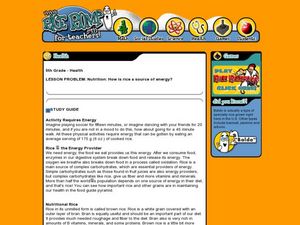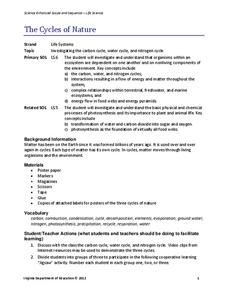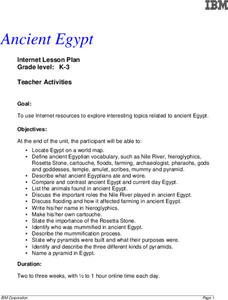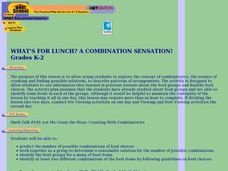Curated OER
Fiber - Adding It To The Diet - Skill Supplement
Students examine and prepare a recipe and state the purpose of each ingredient. They complete a worksheet based on the food pyramid.
Curated OER
Starvation in the Ghettos
Young scholars consider the lack of nutrition experienced in Holocaust ghettos. For this Holocaust lesson, students investigate the Nazi policy of starving people out of the ghettos through their food rationing program. Young scholars...
Curated OER
Fiber - Adding it to the Diet - Skill Supplement
Food preparation that supports the concepts of adding fiber and water to the diet. Identify fiber, its sources and functions. National Standard 14.2.1 Identify the function of fiber Identify cellulose - non digestible fiber Discuss the...
Curated OER
Rice as a Source of Energy
Fifth graders investigate the nutrition in rice. In this rice lesson, 5th graders discover that rice is a great source of energy. Students compare foods to rice to see the differences in the nutritional value. Students classify foods in...
Curated OER
Biology: living Things and their Environment
Middle schoolers recognize that organisms depend on other organisms. In this organism lesson, students understand symbiotic relationships and competition. Middle schoolers explain food chains and food webs. Students understand that...
Nemours KidsHealth
Breakfast: Grades K-2
Students investigate nutrition and the role breakfast plays in everyday life. In this healthy eating activity, students discuss their own breakfast habits and the meal they would prefer to have every morning. Students practice...
Curated OER
Starvation in the Ghettos
Students investigate how human beings survive under camp and ghetto life's extreme condition while understanding the USRDA requirements. They recognize the suffering and loss of life due to the lack of adequate nutrition.
Curated OER
Description and Modifying: What's On Your Plate?
Young scholars create a food product and an advertisement promoting it. In this description and advertising lesson, students read children's book for inspiration and discover advertising techniques. Young scholars complete their ads...
Population Connection
The Peopling of Our Planet
How many people live on the planet, anyway? The first resource in a six-part series covers the topic of the world population. Scholars work in groups to conduct research and make population posters after learning about the global...
Virginia Department of Education
The Cycles of Nature
Encourage peer collaboration and assist with the creation of visual aids to identify carbon, water, and nitrogen cycles as your class learns more about nature. They discuss relative information, create a visual aid depicting the chosen...
Nemours KidsHealth
Breakfast
How can breakfast help you to avoid feeling sluggish and distracted throughout the day? After reading informational articles, learners will discuss how to overcome obstacles to eating breakfast, brainstorm ideas for quick breakfasts, and...
Curated OER
Feeding Your Fish
Students discuss nutrition and diet. They look at copies of Tetra's Daily Nutrition Pyramid for Tropical Fish. They compare the fish feeding pyramid to the pyramid for human nutrition. Students examine a can of fish food.
Curated OER
Peanuts
Students explore the benefits of peanuts. In this peanut lesson plan, students explore the nutritional benefits of peanuts as they complete worksheet activities.
Curated OER
Pancake Express
Students participate in a variety of manipulative skills in cross-curricular activities (dramatic play, reading, problem solving) to improve creativity and health education.
Curated OER
A Well Balanced Meal
Learners are given paper plates and pictures of food. They are to glue the foods they would eat that would make a balanced meal.
Curated OER
Fit or Fat?
Students learn about health by creating healthy snacks, healthy menus, and recording their fat intake with certain foods. In this health lesson plan, students also focus on how exercise can help them stay healthy and loose unhealthy weight.
Curated OER
Cooking a Few of my Favorite Things
Second graders publish a class cookbook of their own recipes. They explore the nutritional value of foods, calculate the measurements, and prepare a healthy recipe for the class.
Curated OER
Depression Nutrition Plan
Students plan meals for a day based on their own caloric needs, make a shopping list, and "shop" on line. In this Great Depression nutrition plan instructional activity, students calculate their caloric needs and plan meals before...
Curated OER
Computation: How can we use rice to solve problem questions?
Fourth graders graph metric tons of rice produced by various countries. In this graphing instructional activity, 4th graders follow problem solving steps to answer questions about rice nutrition and then graph the amount of rice...
Curated OER
NickNews: Winners and Losers
Students view the excerpt from NickNews entitled, "Winners and Losers." In groups, they categorize a variety of words and images relating to weight, healthy eating, and healthy lifestyle. They discuss adopting positive eating habits,...
Curated OER
Nutrition
Fourth graders, with a partner, design, construct and create a title card with a picture and a fact card based on one of the food groups in the Nutrition Pyramid. They determine the nutritional value of foods in his/her diet and design...
Curated OER
Ancient Egypt
Students use the internet to research topics on Ancient Egypt. They practice using new vocabulary and identify the types of food they ate and clothing they wore. They explain the role of the Nile as well.
Curated OER
Haiti: Still in Crisis, but No Longer in the News
Pupils study the Haitian crisis and learn about the needs and ways to help the situation. In this Haitian crisis lesson, students study the Maslow's "Needs Pyramid". Pupils study the media coverage of the earthquake and then answer...
Curated OER
What's For Lunch? A Combination Sensation!
Students combine different foods to make possible lunches and determine the specific combinations of lunches that can be made from a finite set of foods.

























